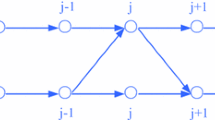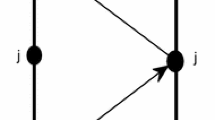Abstract
In this paper, a new lattice hydrodynamic traffic flow model is proposed by considering the driver’s anticipation effect (DAE) in sensing optimal current difference (OCD) for two-lane system. The effect of anticipation parameter on the stability of traffic flow is examined through linear stability analysis and shown that it can significantly enlarge the stability region on the phase diagram. Nonlinear analysis is conducted, and mKdV equation is derived to describe propagation behavior of a density wave near the critical point. The driver’s physical delay in sensing optimal current difference effect is also investigated and found that it has different effect on two-lane traffic based on whether lane changing is allowed or not. Simulation results are found in good agreement with the theoretical findings, which confirms that traffic jam can be suppressed efficiently by considering the DAEOCD effect in a two-lane traffic system.











Similar content being viewed by others
References
Jiang, R., Wu, Q.S., Zhu, Z.J.: A new continuum model for traffic flow and numerical tests. Transp. Res. B 36, 405–419 (2002)
Gupta, A.K., Katiyar, V.K.: A new anisotropic continuum model for traffic flow. Phys. A 368, 551–559 (2006)
Gupta, A.K., Katiyar, V.K.: Analyses of shock waves and jams in traffic flow. J. Phys. A Math. Gen. 38, 4069–4083 (2005)
Gupta, A.K., Katiyar, V.K.: Phase transition of traffic states with on-ramp. Phys. A 371, 674–682 (2006)
Gupta, A.K., Redhu, P.: Analyses of the drivers anticipation effect in a new lattice hydrodynamic traffic flow model with passing. Nonlinear Dyn. 76, 1001–1011 (2014)
Huang, H.J., Tang, T.Q., Gao, Z.Y.: Continuum modeling for two-lane traffic flow. Acta Mech. Sin. 22, 131–137 (2006)
Tang, T.Q., Li, C.Y., Wu, Y.H., Huang, H.J.: Impact of the honk effect on the stability of traffic flow. Phys. A 390, 3362–3368 (2011)
Tang, T.Q., Li, C.Y., Huang, H.J., Shang, H.Y.: A new fundamental diagram theory with the individual difference of the drivers perception ability. Nonlinear Dyn. 67, 2255–2265 (2012)
Tang, T.Q., Huang, H.J., Xu, G.: A new macro model with consideration of the traffic interruption probability. Phys. A 387, 6845–6856 (2008)
Tang, T.Q., Huang, H.J., Wong, S.C., Xu, X.Y.: A new overtaking model and numerical tests. Phys. A 376, 649–657 (2007)
Nagatani, T.: Modified KdV equation for jamming transition in the continuum models of traffic. Phys. A 261, 599–607 (1998)
Ge, H.X., Cheng, R.J.: The backward looking effect in the lattice hydrodynamic model. Phys. A 387, 6952–6958 (2008)
Peng, G.H., Cai, X.H., Cao, B.F., Liu, C.Q.: Non-lane-based lattice hydrodynamic model of traffic flow considering the lateral effects of the lane width. Phys. Lett. A 375, 2823–2827 (2011)
Peng, G.H., Cai, X.H., Liu, C.Q., Tuo, M.X.: A new lattice model of traffic flow with the anticipation effect of potential lane changing. Phys. Lett. A 376, 447–451 (2012)
Peng, G.H.: A new lattice model of traffic flow with the consideration of individual difference of anticipation driving behavior. Commun. Nonlinear Sci. Numer. Simul. 18, 2801–2806 (2013)
Kang, Y.R., Sun, D.H.: Lattice hydrodynamic traffic flow model with explicit drivers physical delay. Nonlinear Dyn. 71, 531–537 (2013)
Ge, H.X., Dai, S.Q., Xue, Y., Dong, L.Y.: Stabilization analysis and modified Korteweg–de Vries equation in a cooperative driving system. Phys. Rev. E 71, 066119 (2005)
Ge, H.X., Ge, H.X., Cheng, R.J., Lei, L.: The Korteweg–de Vries soliton in the lattice hydrodynamic model. Phys. A 388, 1682–1686 (2009)
Ge, H.X., Cheng, R.J., Lei, L.: The theoretical analysis of the lattice hydrodynamic models for traffic flow theory. Phys. A 389, 2825–2834 (2010)
Li, X.L., Li, Z.P., Han, X.L., Dai, S.Q.: Effect of the optimal velocity function on traffic phase transitions in lattice hydrodynamic models. Commun. Nonlinear Sci. Numer. Simul. 14, 2171–2177 (2009)
Peng, G.H., Cai, X.H., Liu, C.Q., Cao, B.F.: A new lattice model of traffic flow with the consideration of the driver’s forecast effects. Phys. Lett. A 375, 2153–2157 (2011)
Peng, G.H., Cai, X.H., Cao, B.F., Liu, C.Q.: A new lattice model of traffic flow with the consideration of the traffic interruption probability. Phys. A 391, 656–663 (2012)
Peng, G.H., Nie, F.Y., Cao, B.F., Liu, C.Q.: A drivers memory lattice model of traffic flow and its numerical simulation. Nonlinear Dyn. 67, 1811–1815 (2012)
Nagatani, T.: Jamming transitions and the modified Korteweg–de Vries equation in a two-lane traffic flow. Phys. A 265, 297–310 (1999)
Nagatani, T.: Jamming transition in a two-dimensional traffic flow model. Phys. Rev. E 59, 4857 (1999)
Nagatani, T.: Jamming transition of high-dimensional traffic dynamics. Phys. A 272, 592–611 (1999)
Peng, G.H.: A new lattice model of two-lane traffic flow with the consideration of optimal current difference. Commun. Non. Sci. Numer. Simul. 18, 559–566 (2013)
Wang, T., Gao, Z.Y., Zhao, X.M., Tian, J.F., Zhang, W.Y.: Flow difference effect in the two-lane lattice hydrodynamic model. Chin. Phys. B 21, 070507 (2012)
Peng, G.H.: A new lattice model of the traffic flow with the consideration of the driver anticipation effect in a two-lane system. Nonlinear Dyn. 73, 1035–1043 (2013)
Gupta, A.K., Redhu, P.: Analyses of drivers anticipation effect in sensing relative flux in a new lattice model for two-lane traffic system. Phys. A 390, 5622–5632 (2013)
Zhang, M., Sun, D.H., Tian, C.: An extended two-lane traffic flow lattice model with drivers delay time. Nonlinear Dyn. 77, 839–847 (2014)
Acknowledgments
This work was supported by Chinese Universities Scientific Fund (Grant No. WK0010000032).
Author information
Authors and Affiliations
Corresponding author
Appendix 1
Appendix 1
In this appendix, we give the expansion of each terms in Eq. (8) using Eqs. (17) and (18) to the fifth order of \(\epsilon \).
The expansion of optimal velocity function at the turning point is
Using Eqs. (31) and (32), we get
Some other important expansions are also computed using Eqs. (27)–(33) and are given as
By inserting (27), (28), (30), (33), (34), (35) and (36) into Eq. (8), we obtain Eq. (19).
Rights and permissions
About this article
Cite this article
Sharma, S. Effect of driver’s anticipation in a new two-lane lattice model with the consideration of optimal current difference. Nonlinear Dyn 81, 991–1003 (2015). https://doi.org/10.1007/s11071-015-2046-9
Received:
Accepted:
Published:
Issue Date:
DOI: https://doi.org/10.1007/s11071-015-2046-9




